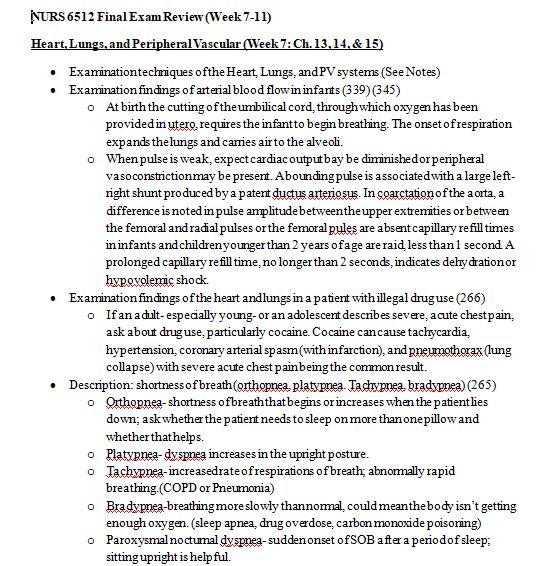Description
NURS 6512N Final Exam Review (Week 7-11)
Heart, Lungs, and Peripheral Vascular (Week 7: Ch. 13, 14, & 15)
- Examination techniques of the Heart, Lungs, and PV systems (See Notes)
- Examination findings of arterial blood flow in infants (339) (345)
- Examination findings of the heart and lungs in a patient with illegal drug use (266)
- Description: shortness of breath (orthopnea, platypnea. Tachypnea, bradypnea) (265)
- Symptoms associated with intrathoracic infection
- Percussion techniques when examining the lungs (273-275)
- Examination findings when percussing the lungs (274)
- Cardiac examination findings for a patient with rheumatic fever (330-331)
- Grading of heart murmurs (311-313)
- Evaluation of ECG tracings (298-299)
- Examination technique for the apical pulse
- Examining technique for different cardiac sounds and their names (309-311)
- Varicosity findings in pregnant women(338) (345)
- Examination of peripheral arteries(338-339)
- Examination of ammonia in breath odor (274)
- Grading of pulses (340)
- Examination findings of a child with Kawasaki disease (349)
- Examination findings of a patient with peripheral edema (344)
- Miscellaneous
Assessing Musculoskeletal Pain (Week 8: Ch. 21 & Review 4)
- Diagnostic tests for patients with carpal tunnel (524) (536)
- Examination techniques used for muscle and joint pain
- Spinal deformities noted during examination (518-519)
- Characteristic examination findings for Rheumatoid Arthritis (513) (538)
- Orthopedic screening evaluation techniques (538-539) (585)
- Characteristic examination findings consistent with Osteoarthritis (538)
- Characteristic examination findings consistent with Gout (536)
- Miscellaneous:
Assessment of Cognition and the Neurologic System (Week 9: Ch. 5 & 22)
- Examination findings associated with Attention Deficit Hyperactivity Disorder (ADHD)- (pg. 77) disorder with genetic component potentially affecting dopamine Behavior patterns of a patient with Schizophrenia, Depression, Anxiety, and Mania(Pg. 76-77).
- Examination techniques of all Cranial Nerves
- Deep Tendon Reflex evaluation- (pg. 564)
- Examination technique and findings for nuchal rigidity- (pg. 565-566) a stiff neck or
- Miscellaneous
Assessing the Genitalia and Rectum Case Study (Week 10: Ch. 16, 18, 19, & 20)
- Significance of Montgomery tubercles
- Examination findings of breast changes during menopausal
- Examination findings consistent with breast cancer in females
- Proper technique for using a speculum during the vaginal exam (430-431)
- Proper technique for the bimanual examination
- Risk factors for testicular and Penile cancer (470)
- Normal vs abnormal bowel findings in newborns
- Proper technique for examining the male genitalia, including the prostate
- Proper Technique for examining the prostate (491)
- Risk factors for colorectal cancer (498)
- Examination findings consistent with Benign Prostate Hypertrophy (498)
- Examination position when assessing anal sphincter tone
- Characteristics of menopausal disorder
- Characteristics of Pelvic Inflammatory Disease (462)
- Examination findings consistent with Prostate Cancer nurs 6512n final exam
- Characteristics of Hydrocele, Epididymitis, Epispadias, and Hypospadias
- Cancer of the Male Genitalia (Penile/Testicular) (470)
- Miscellaneous
The Ethics Behind Assessment (Week 11: Ch. 23 24) [Review: Ch. 16 & 18]
- Ethical considerations when completing adolescent sports physicals with no injuries vs adolescents with previous injuries
- Diagnostics tests used to evaluate sports injuries (583, 585-587, 588-589)
- Examination of children with heart murmurs when conducting a sports physical (583)
- Ethical considerations to be made as Advanced Practice Registered Nurse
- Miscellaneous










